Captain America Comics #1 (1940)
by Joe Simon & Jack Kirby
Here’s the big one.

The cover is, of course, a classic that has been homaged and parodied countless times.
The fact that Captain America gets to punch Hitler on the cover is historically significant: despite the “March” reference on the cover, the release date was December 20th 1940: just 13 days shy of this pre-dating the attack on Pearl Harbor by a full year.
There are a couple of hilarious details that rarely get mentioned, such as the Nazi radio operator that is completely ignoring the action happening behind him…

…but my favorite detail are the “Sabotage Plans For U.S.A.” plainly labeled as such.

Besides the cover, our first glimpse of the good Captain is the teaser page, where he looks strangely stiff.

Both Simon and Kirby are explicitly credited, something rare in the Golden Age. It could have something to do with the fact that they are both normally credited as writer and penciler, or the deal they had with the publisher… more on that later.

Up to this point in the Golden Age, racketeering was THE main problem superheroes had to deal with. But from 1941 another threat will take equal representation: sabotage.
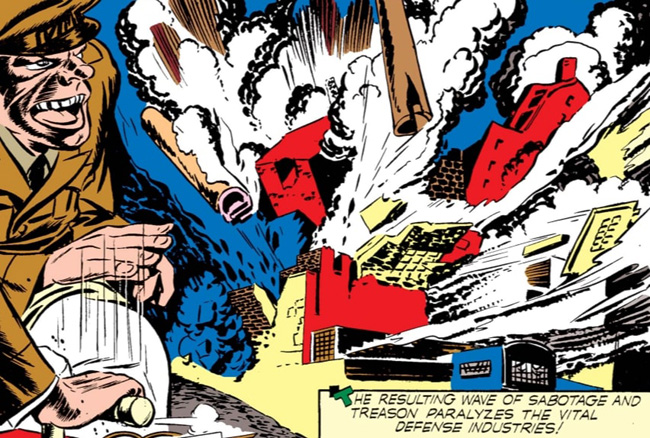
The President is informed about this, and this is the start of a LONG tradition of how Marvel tends to represent the Presidents of the United States: never by name, mostly in the shadows or without showing the real face, but making it obviously clear what President this is: there is no mistaking this guy for anyone but Franklin Delano Roosevelt.

While Namor and the Human Torch were shown to be living in the same universe almost from the start, notice that at this point Captain America is considered to be on his own.

We then follow some Army officials being given a tour of a secret project, which is carried out behind the front of a small shop.
One part that gets repeated throughout most retelling is the old woman taking care of the shop being a much younger woman in disguise, Agent X-13.
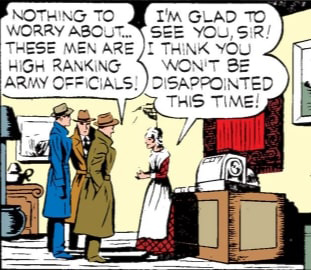

Agent X-13 will retroactively be identified to be Betsy Ross, who in 1948 will briefly replace Bucky as Captain America’s sidekick: Golden Girl.

That version of Captain America will later be revealed to be a different character, but we will eventually talk about Golden Girl’s first appearance because… uhm, that story is something.

Back to the secret project, we now see a “frail young man” being injected with something.
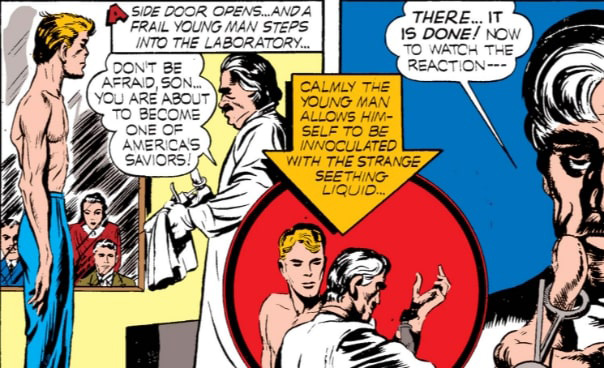
It’s not called “Super-Soldier Serum” in the story, and there is no mention of the “Vita-Rays” that are added by future retellings. Here, the serum does everything on its own.
Notice that the serum also increases Cap’s intelligence, something that I don’t think is officially acknowledged until the 2000s.

Also: Captain America was NOT supposed to be sent to war in this period, but just to deal with spies and saboteurs.
Also also: is it just me or in addition to giving him a six-pack, the serum gave him a double set of pecs?

The project has been infiltrated by a spy from the Gestapo (???) that murders the scientist.
Who at this point is named Reinstein, a name that won’t stick too much.
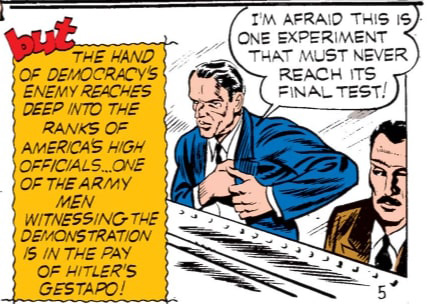
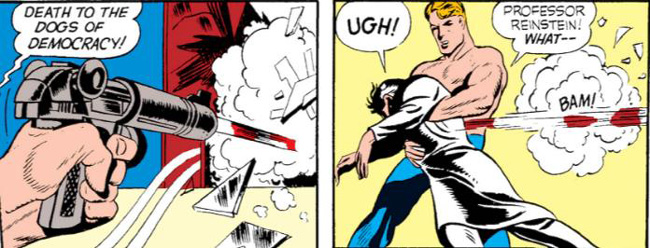
Cap wastes no time demonstrating the effectiveness of the serum.
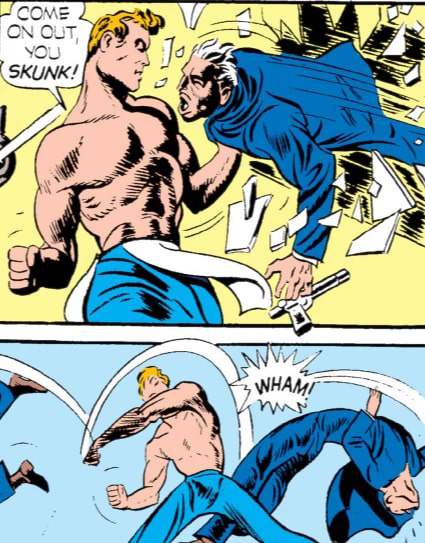
The spy is then electrocuted by some equipment (!!!), and from a modern perspective it’s a bit off-putting to see Captain America so happy about it.
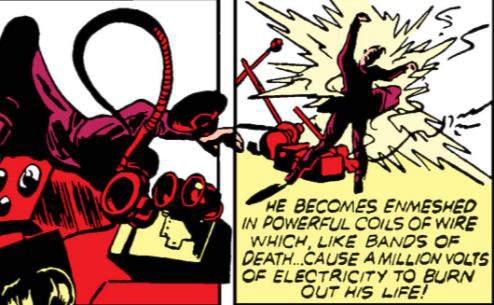
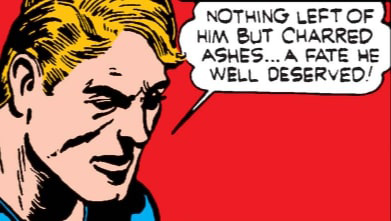
Captain America soon becomes a national sensation.
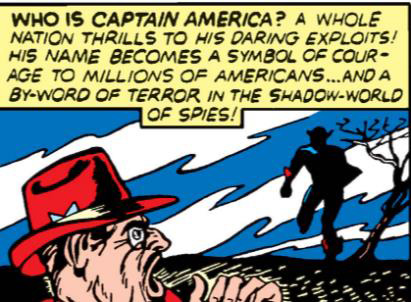

The story is mostly over, but it still has a couple of details to add. First of all, it has to give us Cap’s real name! He wasn’t called Steve Rogers until we see that he’s now in the Army as a regular guy, meeting the local mascot.
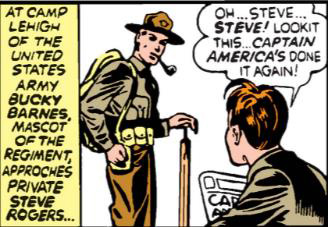
And he IMMEDIATELY discovers that Steve Rogers is… “gosh gee whiz golly”… Captain America!
So Bucky Barnes takes the very imaginative name Bucky and becomes his sidekick.

While a few sidekicks here and there have shown up, Bucky is arguably the first complete ripoff of Robin building off his popularity.
He even has exactly the same mask (though that’s hardly a distinguishing features), but at least he wears pants.
Historical significance: 10/10
Undoubtedly THE most adapted Golden Age story for Marvel, but an argument could be made that it’s the most adapted Golden Age story, PERIOD, considering how much other origin stories have been changed over the years.
Silver Age-ness: 2/10
It could’ve been a 0/10 until the random addition of Bucky at the end.
Does it stand the test of time? 8/10
Short and to the point, with the usual Golden Age efficiency. Even without all the additional lore added over the years, this still feels like a myth being told for the ages.
Had the story ended with the death of the spy and Captain America taking the costume, it could’ve been even higher. But the final addition of Bucky feels out of place.
I will come back to the rest of the issue soon, but there are many other things to talk about relevant to the origin story.
Starting with what is probably what most comic readers think about when talking about Captain America’s origin: its Silver Age retelling.
Tales of Suspense #63 (1963)
by Stan Lee & Jack Kirby

FDR makes another appearance, and the project that created Captain America is officially named Operation Rebirth here.

Can’t forget the old lady in disguise!

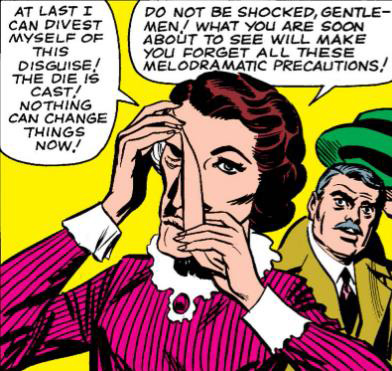
In this version of the story, Steve Rogers DRINKS the formula instead of being injected with it.
Possibly because the Comics Code would not allow them to draw a syringe.
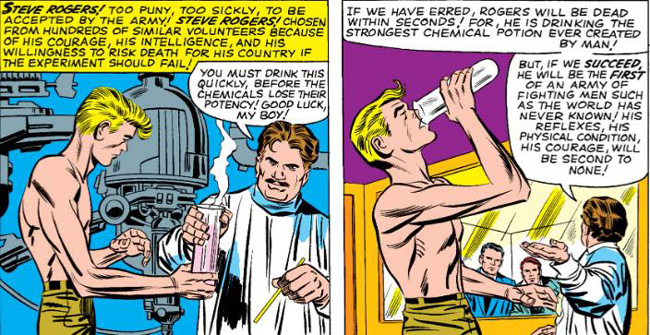
The scientist is also renamed Erskine instead of Reinstein, and once again the serum does all the work.

Bucky is introduced as the camp mascot, but we have the additional detail that his father died in training. Also note the GIGANTIC newspaper title “Captain America nabs new spy ring!”: very similar to the “Captain America nabs spy!” title that we saw in the original.
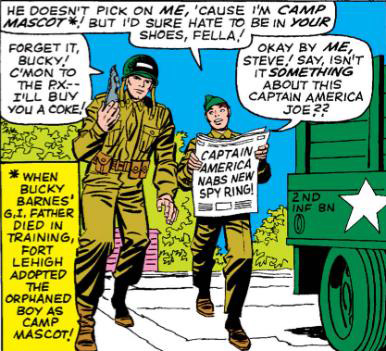
He also discovers Cap’s identity the same way. Which somehow means Cap’s only choice is to have him as his sidekick!
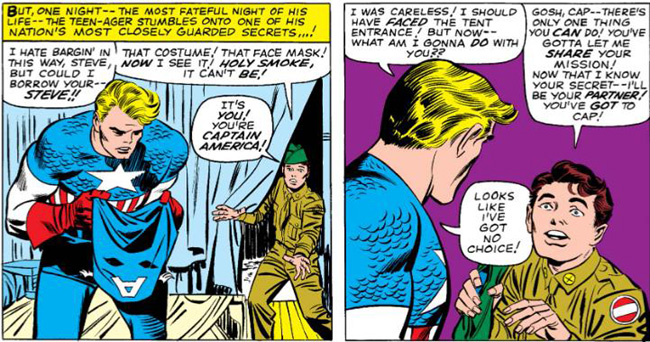
Uhm, Cap, you do know you have other choices besides making him a superhero and killing him, right?

That’s not the ONLY Silver Age retelling by Lee & Kirby.
Captain America #109 (1969)
by Stan Lee & Jack Kirby
Believe it or not, but THIS is when the idea that Steve Rogers repeatedly volunteered after being rejected from the Army comes from.
29 years after his origin story!

The professor is back to being called Reinstein.
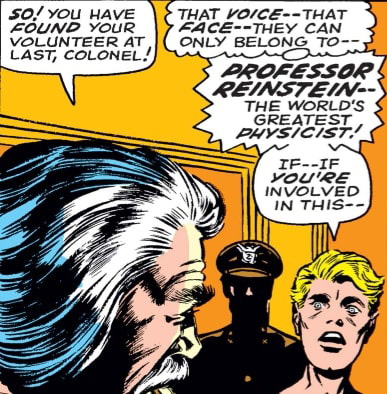
We can’t forget the old lady disguise!

We’re back to the serum being injected instead of Steve drinking it, but the Comics Code is still in effect so it can’t be shown.
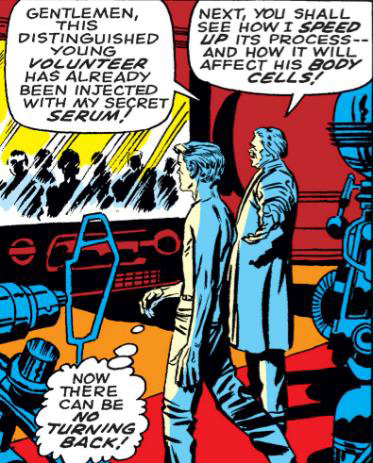
It’s also when the Vita-Rays are introduced as a step in the process.

The spy kills the professor and is defeated, but this time there’s no mention of him being electrocuted to death.
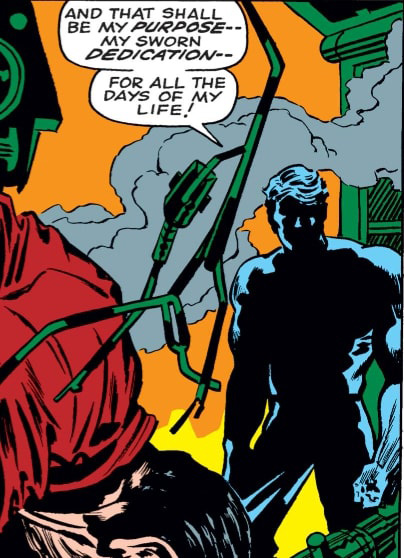
As you can see, there are still a few contradictions in how the story is told. The first one to iron them out is Roy Thomas.
Giant-Size Invaders #1 (1975)
by Roy Thomas & Frank Robbins
This retelling follows all the familiar bits, with the weird decision to rename Agent X-13 as “Agent-R” but more importantly establishing that “Dr. Erskine” is the real name and “Dr. Reinstein” was just a codename.

But we are also back to drinking the serum instead of injecting it.

For the definitive version of the origin that irons out all contradictions, we have to wait for the 40th anniversary of the original!!!
Captain America #255 (1980)
by Roger Stern & John Byrne
Since Captain America’s origin is a fixed point in time, instead of working with comic book time, FDR is properly acknowledged as the President who authorized the project.

Can’t forget the old lady disguise!
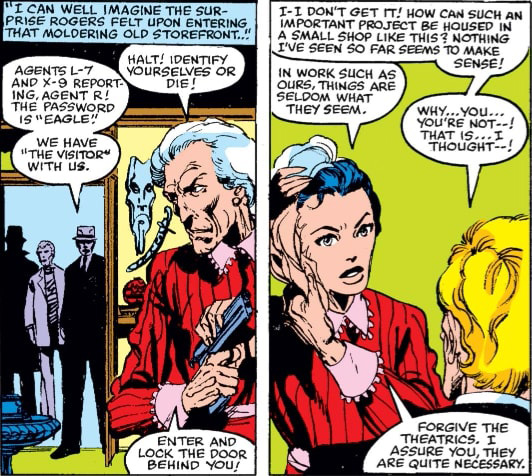
We are reintroduced to the idea that “Dr. Reinstein” is a codename, although one so ridiculous that it doesn’t fool Steve Rogers.
If Erskine’s face is so recognizable, couldn’t they at least have asked him to shave that glorious moustache?

This version mixes all the elements previously established: the serum is both an injection AND a drink.
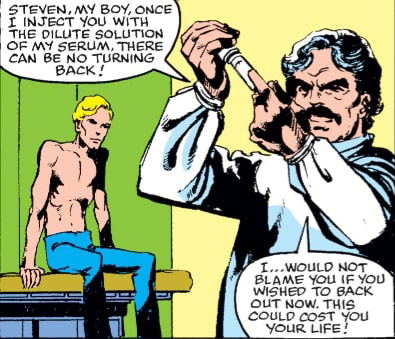
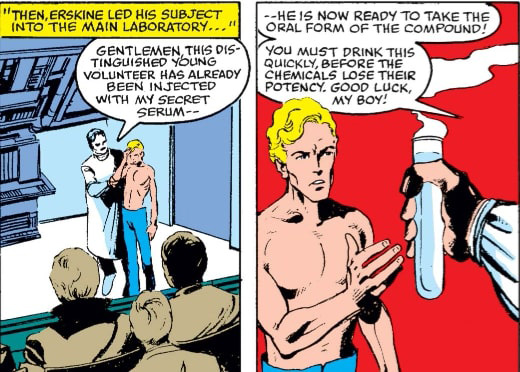
AND he has to be subjected to Vita-Rays. It’s interesting that most attempts we see to replicate the Super-Soldier Serum only take one step… perhaps that’s one of the reasons they tend to fail spectacularly?
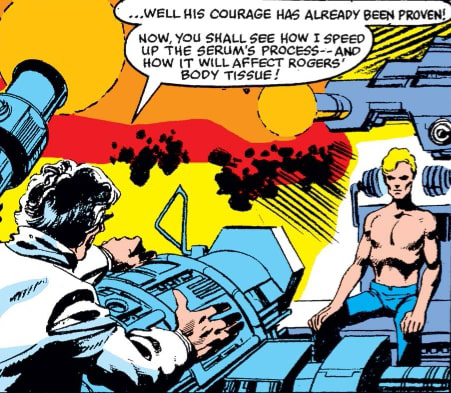
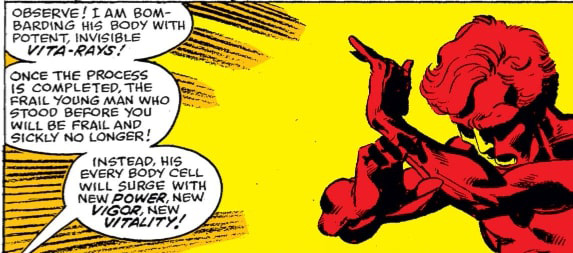
But making Captain America takes more than the serum, because then the Army has a whole new project to train him properly. This MIGHT have been introduced in earlier stories, though.
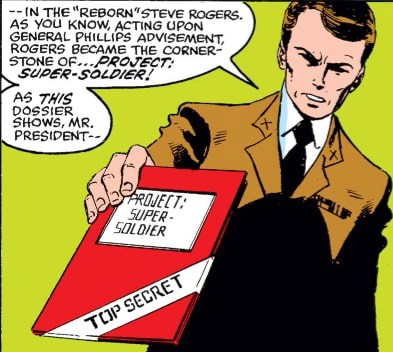
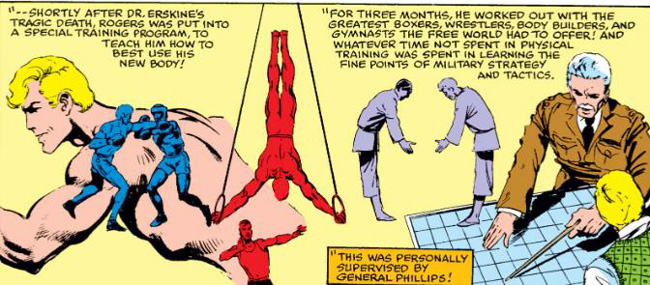
Before talking about Cap’s future and the rest of the stories of this issue… Captain America Comics #1 has a story of its own.
As of 2024, it is the fourth most expensive comic book ever: in 2022, a copy was sold for 3.12 million dollars.
That was a 9.4 grade copy, of which only three are known to exist. Apparently there is a 9.8 grade copy (which is an almost impossibly high grade, so take it with a grain of salt), but which has never been auctioned.
The highest selling comic book is still Action Comics #1, at an astounding 6 million dollars, followed by Superman #1 at 5.3 million dollars and Amazing Fantasy #15 (the first Spider-Man story) at 3.6 million dollars.
SOURCE
As for Captain America’s origins, he was originally conceived by Joe Simon to be called “Super American” but…
No, it didn’t work. There were too many “Supers” around. “Captain America” had a good sound to it. There weren’t a lot of captains in comics. It was as easy as that. The boy companion was simply named Bucky, after my friend Bucky Pierson, a star on our high school basketball team.
JOE SIMON
Captain America Comics #1 turned out to be a HUGE hit, selling nearly a million copies. Which is less than what Superman and Captain Marvel were selling, but still a huge success for Timely Comics.
While the reaction from readers was overwhelmingly positive, it was far from universal:
When the first issue came out we got a lot of… threatening letters and hate mail. Some people really opposed what Cap stood for.
We were inundated with a torrent of raging hate mail and viscous, obscene phone calls. The theme was ‘death to the Jews.’ At first we were inclined to laugh off their threats, but then, people in the office reported seeing menacing-looking groups of strange men in front of the building on 42nd Street and some of the employees were fearful of leaving the office for lunch.
JOE SIMON
Simon & Kirby had an unexpected ally: Mayor La Guardia had the police protecting the Timely offices and even contacted Simon directly!!!
You boys over there are doing a good job. The City of New York will see that no harm comes to you.
FIORELLO LA GUARDIA
Someone else was unhappy with Captain America. MLJ complained that Cap’s shield was too similar to The Shield; according to legend they threatened to sue, but it went nowhere probably because Captain America switched to his more familiar round shield in the SECOND issue.
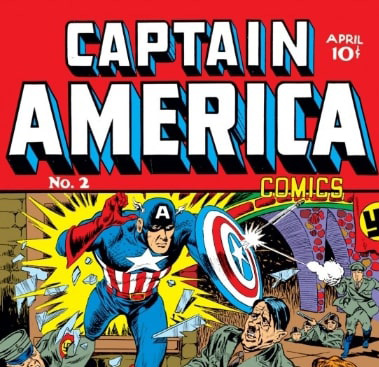
How close is this to the modern character? 5/10
Let’s be honest: the Golden Age Captain America is not exactly a complex character.
While he does get the iconic round shield in the second issue, there seems to be NO Golden Age story where he actually throws it around as a weapon: he uses it like a normal shield.
There IS an instance of Captain America throwing the shield in the familiar fashion, but it’s in a text story published in Captain America Comics #3.
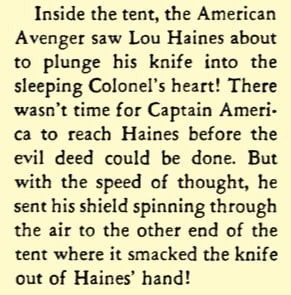
Which would probably have been forgotten by time like all other text stories of the Golden Age, if it wasn’t for its writer. Because that’s the first Stan Lee story ever published.
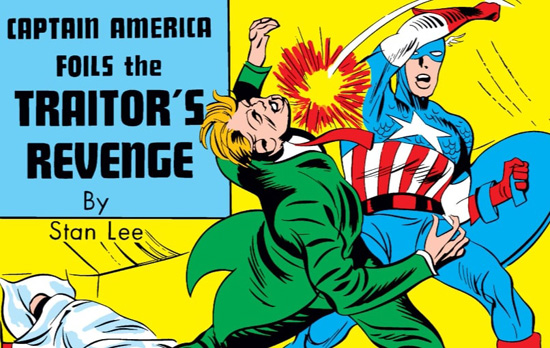
Despite their association to the character, Simon & Kirby didn’t do much work on Captain America.
Simon only wrote the first 2 issue before becoming the editor. He had negotiated 25% percent of the profits of the series to go to him and Kirby, but Simon believed Martin Goodman (the publisher of Timely Comics) was withholding the promise.
Whether that was true or not, Simon and Kirby began seeking work at DC (then called National Comics). This prompted Goodman to fire Simon and Kirby after publishing Captain America Comics #10.
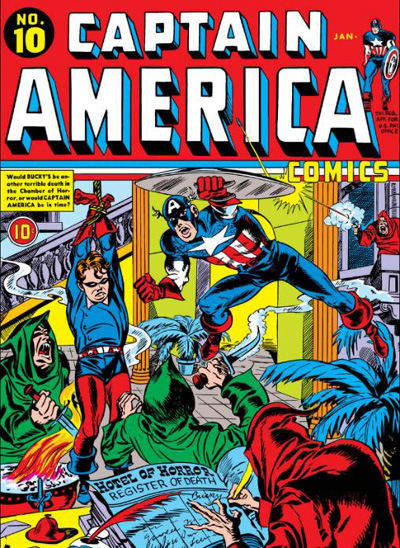
After the war, the character’s appeal declined rapidly. The last issue of Captain America Comics to feature him was #73 in 1949.
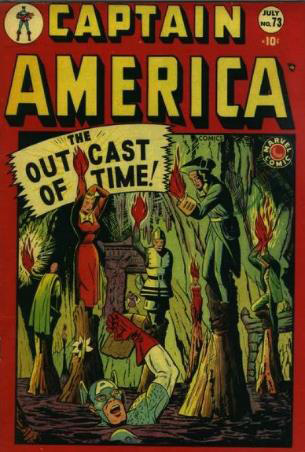
The series is renamed “Captain America’s Weird Tales” for just two issues, #74 and #75, but now it’s a horror anthology that does NOT feature Captain America.

Bizarrely, the series continues in 1954 with the old numbering, featuring a relaunch with Captain America as a “commie smasher”. It’s notable for having some early John Romita artwork, but it was a complete failure: this lasted only 3 issues.
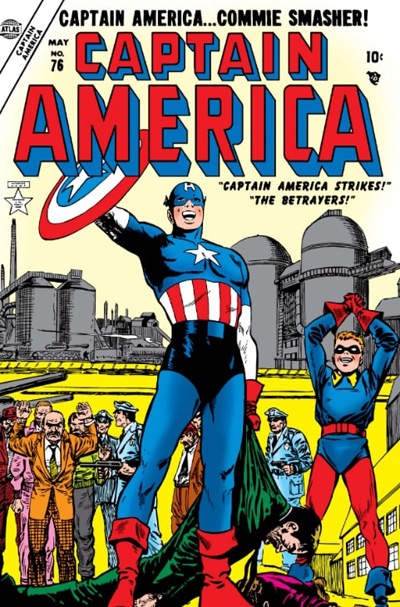
And that was the end of Captain America for a decade.
Until a Captain America impostor briefly showed up in 1963 on the pages of Strange Tales #114, possibly as a trial run for his triumphant return in 1964 on the pages of Avengers #4.
The “Commie Smasher” version, as well as all Captain America stories set after 1945, were retconned into starring other versions of the character and not Steve Rogers.
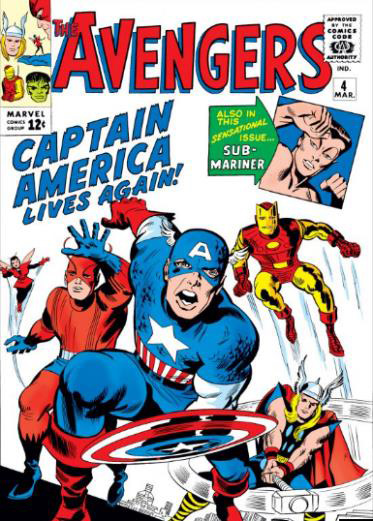
Stan Lee had always disliked the concept of the teenage sidekick, so he made it a point to have Bucky die off-panel at the end of WWII.
And considering that Marvel didn’t have any other prominent sidekicks around, it’s no surprise that Bucky stayed dead for a long time. In fact, it used to be a running joke among comic book readers that “Only Uncle Ben and Bucky stay dead”.
To the point that the very concept of resurrecting him was pretty much universally considered a bad idea… until Ed Brubaker brought him back in 2004 as the Winter Soldier, a move that I’m pretty confident to say is universally liked by Captain America fans.

His return also comes together with retcons about his years as Bucky, because by the 21st century the idea that Captain America was going into adventures with a random teenager without training was too unbelievable.
So we were told that MOST of Bucky’s adventures as a plucky teenager were just propaganda, and he was actually a highly trained agent (even if he was still 16).


I can’t possibly cover ALL of Captain America’s history here… this is already a very long review, and he’s become a very complex character over the decades.
One thing that has to be addressed is that Captain America’s image is ALWAYS influenced by whatever the United States are doing on the world stage at any particular moment, which is an enormously complex topic.
Speaking as a non-US citizen, however, let me just say that even when the United States image is at its lowest the general idea among comic book fans seems to be “America can’t be THAT bad if they have THIS guy!”.
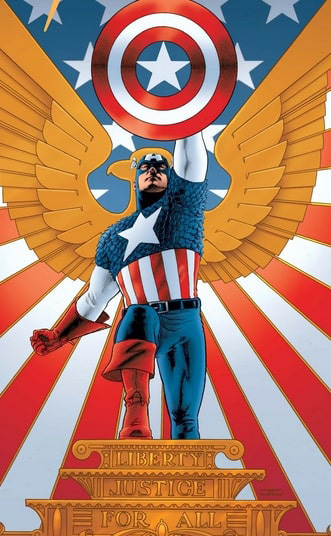
This is already one of my longest reviews so let’s quickly address what else was in Captain America Comics #1.
The second story features hypnotist Sandor and disfigured dwarf Omar.
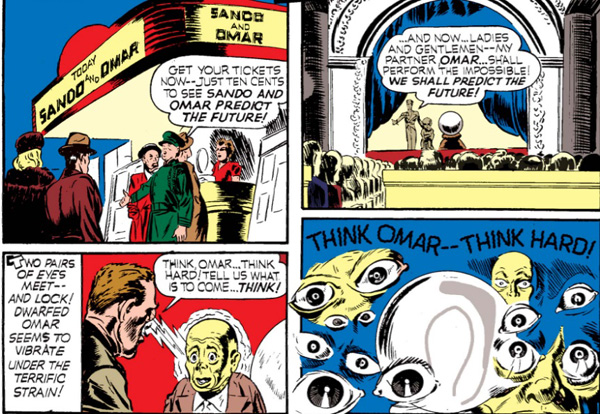
They’re working as saboteurs for the Gestapo, and they end up taking Betsy Ross hostage.
Remember I mentioned her as being retconned into being Agent X-13 and later becoming Cap’s sidekick herself.

When the story will be re-told in the Silver Age on Tales To Astonish #64, her role is replaced by the more familiar Peggy Carter.

The third story sees Captain America and Bucky stop some saboteurs.
You might have started to notice a pattern.
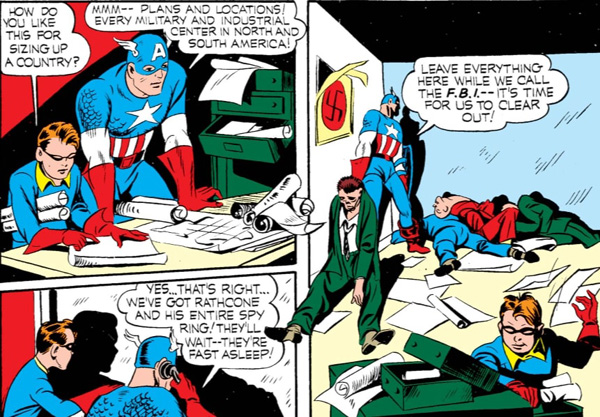
The other highlight of the issue is the debut of the Red Skull, but fortunately I’ve already reviewed it.
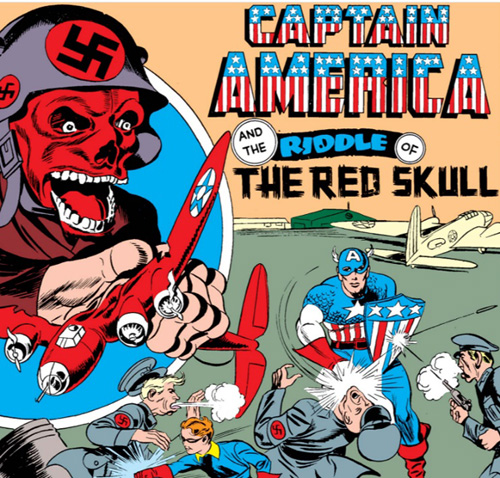
However Captain America is NOT the only protagonist in Captain America Comics #1.
In addition to a story that I will cover in a separate review, there’s “Tuk the caveboy”.

He only gets 5 stories, but it’s interesting to see that A) his name means “Avenger”, sneaking that word into a Captain America comic 24 years in advance B) he’s looking for the lost city of “Attilan”, 25 years before the Inhumans are introduced.
